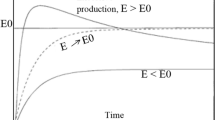Abstract
An energetic model for a hybrid solar–geothermal electric power plant (HSGEPP) is developed to explore the extent to which solar thermal resources can extend and enhance marginal and declining geothermal fields. The model is developed and presented to allow replication in a 4th-year solar engineering thermal design course. The model is applied to a HSGEPP being developed in Turkey, and simulations are run using a typical meteorological year formatted data set. The solar fraction ( f s) of the HSGEPP is equal to the fractional decrease in the geothermal resource usage. The increase in annual f s with the collector field’s solar multiple (M s) is linear up to approximately f s = 0.25 for M s = 1.25, after which the rate of increase in f s begins to decay and f s approaches 0.37 for M s = 5. For M s = 1.25, the monthly solar fraction ranges from 0.05 in December to 0.43 in July.
Access this chapter
Tax calculation will be finalised at checkout
Purchases are for personal use only
Similar content being viewed by others
Abbreviations
- 2A:
-
Two-axis tracking
- CST:
-
Concentrating solar thermal
- DNI:
-
Direct normal insolation or irradiance
- EW:
-
One-axis tracking in east–west direction
- GEPP:
-
Geothermal electric power plant
- HCE:
-
Heat collecting element
- HSGEPP:
-
Hybrid solar–geothermal electric power plant
- HTF:
-
Heat transfer fluid
- IAM:
-
Incidence angle modifier
- NS:
-
One-axis tracking in north–south direction
- PTC:
-
Parabolic trough collector
- STE:
-
Solar thermal electric
- TMY2:
-
Typical meteorological year 2
- A coll,o :
-
Nominal collector area m2
- a o a 1, a 2 :
-
Constants for IAM, units vary and are as shown in Table 1
- c geo :
-
Specific heat capacity for geothermal brine
- c o c 1, c 2 :
-
Constants for L t, units vary and are as shown in Table 1
- f :
-
Fraction
- Go,n :
-
Extraterrestrial normal irradiance W m−2
- h fg :
-
Enthalpy of evaporation kJ kg−1
- I :
-
Insolation Wh m−2
- L :
-
Loss (units vary)
- M s :
-
Solar multiple
- n :
-
Day number
- q :
-
Heat transfer (Wh) or rate of heat transfer (W)
- T :
-
Temperature °C
- t :
-
Time hour with minutes expressed as a fraction
- Δt:
-
Time period hour with minutes expressed as a fraction
- εorc :
-
ORC exergetic efficiency
- ϕ:
-
Latitude o
- γ:
-
Azimuth o
- η:
-
Efficiency fraction or %
- θ:
-
Angle of incidence o
- θz :
-
Solar zenith angle o
- ζ:
-
Error units vary
- b:
-
Beam
- coll:
-
Collector
- d:
-
Diffuse
- db:
-
Dry bulb
- dct:
-
Dry cooling tower
- ew:
-
East–West tracking surface
- geo:
-
Geothermal
- inj:
-
Injection
- j:
-
Type of tracking: 2A EW or NS
- h:
-
ORC hot side
- n:
-
Normal
- o:
-
Maximum or nominal
- opt:
-
Optical
- orc:
-
Organic Rankine cycle
- s:
-
Solar
- t:
-
Thermal
- wb:
-
Wet bulb
- wct:
-
Wet cooling tower
- n:
-
Collector thermal loss exponent
- *:
-
Assumes no night
References
Greenhut AD (2010) Modeling and analysis of hybrid geothermal-solar thermal energy conversion systems. MSc Thesis, Massachusetts Institute of Technology
Lentz Á, Almanza R (2006) Solar–geothermal hybrid system. Appl Therm Eng 26(14–15):1537–1544
Lentz Á, Almanza R (2006) Parabolic troughs to increase the geothermal wells flow enthalpy. Sol Energy 80(10):1290–1295
Greenhut AD, Tester JW, DiPippo R, Field R, Love C, Nichols K, Augustine C, Batini F, Price B, Gigliucci G, et al. (2010) Solar–geothermal hybrid cycle analysis for low enthalpy solar and geothermal resources. Proceedings world geothermal congress, 2010
Astolfi M, Xodo L, Romano MC, Macchi E (2011) Technical and economical analysis of a solar–geothermal hybrid plant based on an Organic Rankine Cycle. Geothermics 40(1):58–68
Kuyumcu OC, Solaroglu ZDU, Akar S, Serin O (2013) Hybrid geothermal and solar thermal power plant case study: Gumuskoy GEPP. Geo-Heat Center Bulletin 31:19–24
Kutscher C, Burkholder F, Kathleen Stynes J (2011) Generation of a parabolic trough collector efficiency curve from separate measurements of outdoor optical efficiency and indoor receiver heat loss. J Sol Energy Eng 134(1):011012–011012
Dudley VE, Kolb GJ, Mahoney AR, Mancini TR, Matthews CW, Sloan M, Kearney D (1994) Test results: SEGS LS-2 solar collector. NASA STIRecon Tech Rep N 96:11437
Duffie JA, Beckman WA (2006) Solar engineering of thermal processes, 3rd edn. John Wiley, New York, NY
Patnode AM (2006) Simulation and performance evaluation of parabolic trough solar power plants. MSc Thesis, University of Wisconsin-Madison
Vijayaraghavan S (2003) Thermodynamic studies on alternate binary working fluid combinations and configurations for a combined power and cooling cycle. MSc Thesis, University of Florida
Acknowledgments
This work is supported with grants from TUBITAK (7120763) and EU-SFERA (228296). The educational component of this work supports the outreach and dissemination of activities of the EU-Solaris Project (FP7 312833). The authors would like to thank the support of BM Holding, TYT, and YGA.
Author information
Authors and Affiliations
Corresponding author
Editor information
Editors and Affiliations
Rights and permissions
Copyright information
© 2015 Springer International Publishing Switzerland
About this chapter
Cite this chapter
Baker, D.K., Özalevli, C.C., Sömek, S.K. (2015). Technical Study of a Hybrid Solar–Geothermal Power Plant and Its Application to a Thermal Design Course. In: Dincer, I., Colpan, C., Kizilkan, O., Ezan, M. (eds) Progress in Clean Energy, Volume 2. Springer, Cham. https://doi.org/10.1007/978-3-319-17031-2_58
Download citation
DOI: https://doi.org/10.1007/978-3-319-17031-2_58
Publisher Name: Springer, Cham
Print ISBN: 978-3-319-17030-5
Online ISBN: 978-3-319-17031-2
eBook Packages: EnergyEnergy (R0)




